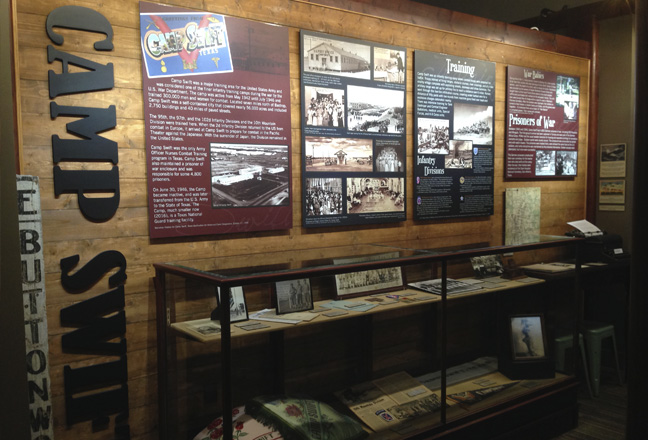County Magazine | April 23, 2023
County museums celebrate local pride and history, one tea cup at a time

What's a county to do with all its residents' old marching band uniforms and state football memorabilia? Or the stained glass from the first church, or 100-year-old letters from children, now long since buried, written to Santa?
Keep them and put them on display, of course.
These are "objects of material culture" in the museum world, and they arecritical to any county, city or community museum’s success, said Nicole DeGuzman, executive director of the Bastrop County Historical Society. "By collecting things that matter to them, we are reaching the community in a way that is reflective of them."
At her museum in Bastrop, a committee ultimately decides whether to accept the material into the permanent collection. DeGuzman, who is originally from Minnesota but moved to Texas after a 20-inch snowstorm one May, says it is the strongest acquisition program of any museum she's seen in 25 years in the field.
The Bastrop County Museum started in the early 1950s, when residents brought together their photographs, documents and artifacts to preserve the history of the area.
The Bastrop County Historical Society now has a staff of eight, including DeGuzman. The new executive director, who was previously director of the Scurry County Museum in West Texas, has helped shift the focus to diversifying the ways that the museum engages with the community. For instance, the museum has a researcher specifically working on Hispanic heritage.
"He's out there in the community, talking to stakeholders, getting objects from that community that we can incorporate into the permanent exhibit," DeGuzman said.
The researchers have also revamped the oral history project, in which trained volunteers record interviews with people of all ages and backgrounds, not just the oldest members of the community with the longest memories.

an event called the Runaway Scrape.
(Credit: Bastrop County Museum)
Those interviews are then transcribed, which gives future researchers access to firsthand accounts from a variety of people who call Bastrop home today. She hopes to do one of these per month and welcomes volunteers from the community.
DeGuzman said one of the most successful events last year was the Dia de los Muertos exhibit during the fall, which included altars created by families in town for their loved ones. "It was a living, breathing exhibit that the community loved," DeGuzman said. "We are definitely bringing that back." In May, the county museum is also reviving YesterFest, which hasn't taken place since 2016.
DeGuzman said what is happening in Bastrop is happening at museums across the state. For years, many county museums focused solely on heritage history, and now many of them are engaging with the people who live in the area, not just people who are passing through and want to learn about a place.
"This is how you become relevant in a community. It's what museumsshould be doing," she said.
Breathing new life into old buildings
The state has more than 1,000 local museums, according to the Texas Historical Commission, which offers training and support for museum curators and archivists. (This spring, the state-run organization hosted half a dozen workshops in cities across Texas on how museums can develop indigenous-focused exhibits.)
Many of these museums are run by local boards that host monthly or quarterly meetings to shape how the organization operates, its upcoming exhibits and any other matters pertaining to the collection. Some are funded by the county and staffed by volunteers; others operate independently of the county and are funded through donations, admission fees and/or grants.
But no matter the size of the collection or the budget, county museums are where residents and visitors alike can learn about Texas history through a hyper-local lens.
At the Deaf Smith County Historical Museum in Hereford, which first came together in the 1960s, the exhibits are housed in an old red brick building that once served as a school for the local Catholic church.

(Credit: Bastrop County Museum)
Inside the building, the museum recreated a general store, a post office and a chapel, where they also host weddings. Outside the museum, visitors can explore a half-dugout, a type of home used by early settlers on the tree-sparse plains. (The museum, with an operating budget of $120,940, is free to visit.)
Some museums build up organically around a large piece of town history that’s just a little too big toget rid of easily, like a caboose, achuckwagon, a windmill or a jail.
Not all county museums have beenaround that long. The Williamson Museum in Georgetown started in the late 1990s and now has a staff of four that oversees its guided ghost tours, two citywide celebrations and traveling trunk and field trip programsto benefit local school children.
Another relatively new county-backed historical restoration is in Burnet, where the old jail downtown has been a fixtureon the square since 1884. The jail once had been converted into city offices, but the county reorganized its office space so that the tourism office could be housed in the restored jail and open it to the public on a limited basis.
When the old jail reopened in 2022, on hand for the ceremony was 95-year-old Vonnie Riddell Fox, daughter of the late Sheriff Wallace Riddell. Fox grew up as one of four children in the small residence inside the jail, delivering trays of food that her mother cooked to the prisoners.

County Museum.
(Credit: Bastrop County Museum)
Volunteers are central to the mission
Part of the success of the Bastrop County Museum is the 40 volunteers who help answer research request questions, DeGuzman said.
"They have a fire in their belly," DeGuzman said. "They have become quite versed in the history of Bastrop and can find just about anything."
DeGuzman is part of a new all-county museum consortium, led by the Bastrop County Historical Commission, that includes about a dozen museums and libraries across the county. Meeting once a month, the group finds ways for members to share resources and help one another.
As a new resident herself, DeGuzman said she appreciates living in a place that celebrates the past while building its future. "Preserving our history is the cornerstone of understanding where we are today," she said. "Everyone here wants to work together to make Bastrop better. It’s not often that I hear 'no'."
Here's what happening at other Texas county museums this year:The Collin County History Museum, housed in the old post office in McKinney, recently reopened with a new exhibit covering the history of the county, including the movie "Benji," which was filmed in downtown McKinney. Bell County Museum in Temple has a large collection of lithics, including stone tools and arrowheads, in its collection, aswell as a unique set of miniature models of a dozen stately buildings and homesin the area. It also touts the largest publicly held collection of moustache cups in the U.S. (Those are tea cups with an inner shelf across the top edge to prevent coffee or tea from soiling the popular facial hair of the era.) Ellis County Museum hosts the annual Gingerbread Trail Tour of Homes, now in its 53rd year, each June to showcase the Queen Anne Victorian homes in Waxahachie. The museum recently renovated its third floor and has a special exhibit about the history of the tour. DeWitt County Historical Museum, which is housed in the Bates-Sheppard House, made from wood salvaged after the 1886 hurricane that destroyed the coastal town of Indianola, hosted Cuero's 150th birthday celebration this spring. Childress County Heritage Museum has an exhibit focused on the marching band and football team. |

